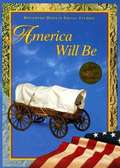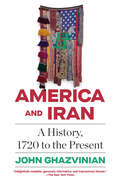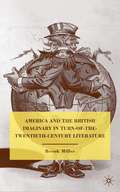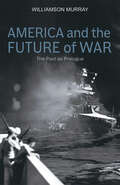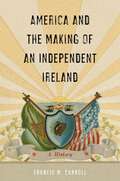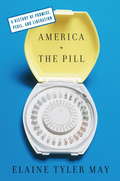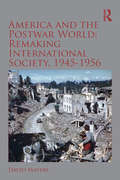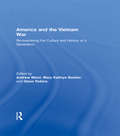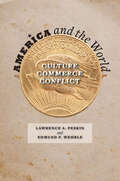- Table View
- List View
America Was Hard to Find: A Novel
by Kathleen AlcottIn the wake of an affair, the lives of an astronaut and a radical are forever altered by the political fault lines of the 1960s, setting off a series of events ricocheting from anti-Vietnam activism to the Apollo program to the AIDS crisis, in this sprawling multigenerational novelEcuador, 1969: An American expatriate, Fay Fern, sits in the corner of a restaurant, she and her young son Wright turned away from the television where Vincent Kahn becomes the first man to walk on the moon.Years earlier, Fay and Vincent meet at a pilots’ bar in the Mojave Desert. Both seemed poised for reinvention—the married test pilot, Vincent, as an astronaut; the spurned child of privilege, Fay, as an activist. Their casual affair ends quickly, but its consequences linger.Though their lives split, their senses of purpose deepen in tandem, each becoming heroes to different sides of the political spectrum of the 1960s and 70s: Vincent an icon with no plan beyond the mission for which he has single-mindedly trained, Fay a leader of a violent leftist group whose anti-Vietnam actions make her one of the FBI’s most wanted. With her last public appearance, a demonstration that frames the Apollo program as a vehicle for distracting the American public from its country’s atrocities, Fay leaves Wright to contend with her legacy, his own growing apathy, and the misdeeds of both his mother and his country.An immense, vivid reimagining of the Cold War era, America Was Hard to Find traces the fallout of the cultural revolution that divided the country and explores the meaning of individual lives in times of upheaval. It also confirms Kathleen Alcott’s reputation as a fearless and vital voice in fiction.
America Will Be
by Gary B. Nash J. Jorge Klor de Alva Jacqueline M. Cordova Beverly J. ArmentoSocial studies textbook.
America Yesterday and Today
by Carol Berkin Joe Bertram Frantz Joan E. SchreiberSurveys the history of the United States from its first people through the European settlements and changes as a nation up to the present. Includes a unit on current conditions in neighboring countries in North, Central, and South America.
America and Iran: A History, 1720 to the Present
by John GhazvinianIn recent times, the United States and Iran have seemed closer to war than peace, but that is not where their story began. When America was in its infancy, Thomas Jefferson and John Quincy Adams turned to the history of the Persian Empire as they looked for guidance on how to run their new country. And in the following century, Iranian newspapers heralded America as an ideal that their own government might someday emulate. How, then, did the two nations become the adversaries that they are today? In this rich, fascinating history, John Ghazvinian traces the complex story of America and Iran over three centuries. Drawing on years of research conducted in both countries – including access to Iranian government archives rarely available to Western scholars – he leads us through the four seasons of US-Iranian relations: from the spring of mutual fascination, where Iran, sick of duplicitous Britain and Russia interfering in its affairs, sought a relationship with the United States, to the long, dark winter of hatred that we are yet to see end. A revealing account, America and Iran lays bare when, where and how it all went wrong – and why it didn&’t have to be this way.
America and Iran: A History, 1720 to the Present
by John GhazvinianAn important, urgently needed book--a hugely ambitious, illuminating portrait of the two-centuries-long entwined histories of Iran and America, and the first book to examine, in all its aspects, the rich and fraught relations between these two powers--once allies, now adversaries. By an admired historian and the author of Untapped: The Scramble for Africa's Oil ("he would do Graham Greene proud"--Kirkus Reviews).In this rich, fascinating history, John Ghazvinian traces the complex story of the relations of these two powers back to the Persian Empire of the eighteenth century--the subject of great admiration of Thomas Jefferson and John Quincy Adams--and an America seen by Iranians as an ideal to emulate for their own government.Drawing on years of archival research both in the United States and Iran--including access to Iranian government archives rarely available to Western scholars--the Iranian-born, Oxford-educated historian leads us through the four seasons of U.S.-Iran relations: the "spring" of mutual fascination; the "summer" of early interactions; the "autumn" of close strategic ties; and the long, dark "winter" of mutual hatred.Ghazvinian, with grasp and a storyteller's ability, makes clear where, how, and when it all went wrong. And shows why two countries that once had such heartfelt admiration for each other became such committed enemies; showing us, as well, how it didn't have to turn out this way.
America and Iraq: Policy-making, Intervention and Regional Politics (Contemporary Security Studies)
by David Ryan Patrick KielyThis edited volume provides an overview on US involvement in Iraq from the 1958 Iraqi coup to the present-day, offering a deeper context to the current conflict. Using a range of innovative methods to interrogate US foreign policy, ideology and culture, the book provides a broad set of reflections on past, present and future implications of US-Iraqi relations, and especially the strategic implications for US policy-making. In doing so, it examines several key aspects of relationship such as: the 1958 Iraqi Revolution; the impact of the 1967 Arab-Israeli War; the impact of the Nixon Doctrine on the regional balance of power; US attempts at rapprochement during the 1980s; the 1990-91 Gulf War; and, finally, sanctions and inspections. Analysis of the contemporary Iraq crisis sets US plans against the ‘reality’ they faced in the country, and explores both attempts to bring security to Iraq, and the implications of failure.
America and Romania in the Cold War: A Differentiated Détente, 1969-80 (Cold War History)
by Paschalis PechlivanisThis book examines the US foreign policy of differentiation towards the socialist regimes of Eastern Europe as it was implemented by various administrations towards Ceausescu’s Romania from 1969 to 1980. Drawing from multi-archival research from both US and Romanian sources, this is the first comprehensive analysis of differentiation and shows that Washington’s Eastern European policy in the 1970s was more nuanced than the common East vs. West narrative suggests. By examining systemic Cold War factors such as the rise of détente between the two superpowers and the role of agency, the study deals with the dynamics that shaped the evolution of American-Romanian relations after Bucharest’s opening towards the West, and the subsequent embrace of this initiative by Washington as an instrument to undermine the unity of the Soviet bloc. Furthermore, it revises interpretations about Carter’s celebrated human rights policy based on the Romanian case, pointing towards a remarkable continuity between the three administrations under examination (Nixon, Ford and Carter). By doing so, this study contributes to the field by highlighting a largely neglected aspect of US foreign policy and uncovers the subtleties of Washington’s relations with one of the most vigorous actors of the Eastern European bloc. This book will be of much interest to students of Cold War Studies, US foreign policy, Eastern European politics and International Relations in general.
America and Vietnam: The Elephant and the Tiger
by Albert MarrinExamines the political history, military events, social impact, and long-term effects of the Vietnam War.
America and World War I: A Selected Annotated Bibliography of English-Language Sources (Routledge Research Guides to American Military Studies)
by David WoodwardAmerica and World War I, the first volume in the new Routledge Research Guides to American Military Studies series, provides a concise, annotated guide to the vast amount of resources available on the Great War. With over 2,000 entries selected from a wide variety of publications, manuscript collections, databases, and online resources, this volume will be an invaluable research tool for students, scholars, and military history buffs alike. The wide range of topics covered include war films and literature, to civil-military relations, to women and war. Routledge Research Guides to American Military Studies will include concise, easy-to-use bibliographic volumes on different American military campaigns throughout history, as well as tackling timely subjects such as women in the military and terrorism.
America and the Americas: The United States in the Western Hemisphere (2nd edition)
by Lester D. LangleyIn this completely revised and updated edition of America and the Americas, Lester D. Langley covers the long period from the colonial era into the twenty-first century, providing an interpretive introduction to the history of U. S. relations with Latin America, the Caribbean, and Canada. Langley draws on the other books in the series to provide a more richly detailed and informed account of the role and place of the United States in the hemisphere. In the process, he explains how the United States, in appropriating the values and symbolism identified with "America," has attained a special place in the minds and estimation of other hemispheric peoples. Discussing the formal structures and diplomatic postures underlying U. S. policy making, Langley examines the political, economic, and cultural currents that often have frustrated inter-American progress and accord.
America and the British Imaginary in Turn-of-the-Twentieth-Century Literature
by Brook MillerIn an innovative reading of fin-de-siecle cultural texts, Miller argues that British representations of America, Americans, and Anglo-American relations at the turn of the twentieth century provided an important forum for cultural distinction.
America and the French Nation, 1939-1945
by Julian G. HurstfieldHurstfield analyzes American responses--diplomatic, military, intellectual, and popular--to the plight of the French nation during World War II, as the constitution of the Third Republic was suspended, Petain ruled in Vichy, the Germans administered Occupied France, DeGaulle organized the Free French movement, and an internal French resistance slowly gathered strength. Interweaving diplomatic and intellectual history, the author combines analysis with a sensitive account of American currents of opinion.Originally published in 1986.A UNC Press Enduring Edition -- UNC Press Enduring Editions use the latest in digital technology to make available again books from our distinguished backlist that were previously out of print. These editions are published unaltered from the original, and are presented in affordable paperback formats, bringing readers both historical and cultural value.
America and the Future of War: The Past as Prologue
by Williamson MurrayThroughout the world today there are obvious trouble spots that have the potential to explode into serious conflicts at any time in the immediate or distant future. This study examines what history suggests about the future possibilities and characteristics of war and the place that thinking about conflict deserves in the formation of American strategy in coming decades. The author offers a historical perspective to show that armed conflict between organized political groups has been mankind's constant companion and that America must remain prepared to use its military power to deal with an unstable, uncertain, and fractious world.Williamson Murray shows that while there are aspects of human conflict that will not change no matter what advances in technology or computing power may occur, the character of war appears to be changing at an increasingly rapid pace with scientific advances providing new and more complex weapons, means of production, communications, and sensors, and myriad other inventions, all capable of altering the character of the battle space in unexpected fashions. He explains why the past is crucial to understanding many of the possibilities that lie in wait, as well as for any examination of the course of American strategy and military performance in the future—and warns that the moral and human results of the failure of American politicians and military leaders to recognize the implications of the past are already apparent.
America and the Holocaust: A Documentary History
by Rafael MedoffThe first comprehensive volume to teach about America&’s response to the Holocaust through visual media, America and the Holocaust: A Documentary History explores the complex subject through the lens of one hundred important documents that help illuminate and amplify key episodes and issues. Each chapter pivots on five key documents: two in image form and three in text form. Individual introductions that contextualize the documents are followed by explanatory text, analysis of historical implications, and suggestions for further reading. A concluding state-of-the-field essay documents how scholars have arrived at the presented information. A complementary teacher&’s guide with questions for discussion is available online. The twenty chapters address a broad range of subjects and events, among them America&’s response to Hitler&’s rise, U.S. public opinion about Jews, immigration policy, the Wagner-Rogers bill to save children, American rescuers, news coverage of atrocities, American Jewish and Christian responses to the Holocaust, the campaign for U.S. rescue action, the question of bombing Auschwitz, and liberation. Viewing real documents as a means to understanding core issues will deepen reader involvement with this material. High school and college students as well as general readers of all levels of knowledge will be engaged in understanding this crucial chapter in American history and weighing questions regarding mass atrocities in our own era.
America and the Japanese Miracle
by Aaron ForsbergIn this book, Aaron Forsberg presents an arresting account of Japan's postwar economic resurgence in a world polarized by the Cold War. His fresh interpretation highlights the many connections between Japan's economic revival and changes that occurred in the wider world during the 1950s. Drawing on a wealth of recently released American, British, and Japanese archival records, Forsberg demonstrates that American Cold War strategy and the U.S. commitment to liberal trade played a central role in promoting Japanese economic welfare and in forging the economic relationship between Japan and the United States. The price of economic opportunity and interdependence, however, was a strong undercurrent of mutual frustration, as patterns of conflict and compromise over trade, investment, and relations with China continued to characterize the postwar U.S.-Japanese relationship.Forsberg's emphasis on the dynamic interaction of Cold War strategy, the business environment, and Japanese development challenges "revisionist" interpretations of Japan's success. In exploring the complex origins of the U.S.-led international economy that has outlasted the Cold War, Forsberg refutes the claim that the U.S. government sacrificed American commercial interests in favor of its military partnership with Japan.
America and the Japanese Miracle: The Cold War Context of Japan's Postwar Economic Revival, 1950-1960
by Aaron ForsbergIn this book, Aaron Forsberg presents an arresting account of Japan's postwar economic resurgence in a world polarized by the Cold War. His fresh interpretation highlights the many connections between Japan's economic revival and changes that occurred in the wider world during the 1950s. Drawing on a wealth of recently released American, British, and Japanese archival records, Forsberg demonstrates that American Cold War strategy and the U.S. commitment to liberal trade played a central role in promoting Japanese economic welfare and in forging the economic relationship between Japan and the United States. The price of economic opportunity and interdependence, however, was a strong undercurrent of mutual frustration, as patterns of conflict and compromise over trade, investment, and relations with China continued to characterize the postwar U.S.-Japanese relationship.Forsberg's emphasis on the dynamic interaction of Cold War strategy, the business environment, and Japanese development challenges "revisionist" interpretations of Japan's success. In exploring the complex origins of the U.S.-led international economy that has outlasted the Cold War, Forsberg refutes the claim that the U.S. government sacrificed American commercial interests in favor of its military partnership with Japan.
America and the Making of an Independent Ireland: A History (The Glucksman Irish Diaspora Series #1)
by Francis M. CarrollExamines how the Irish American community, the American public, and the American government played a crucial role in the making of a sovereign independent IrelandOn Easter Day 1916, more than a thousand Irishmen stormed Dublin city center, seizing the General Post Office building and reading the Proclamation for an independent Irish Republic. The British declared martial law shortly afterward, and the rebellion was violently quashed by the military. In a ten-day period after the event, fourteen leaders of the uprising were executed by firing squad.In New York, news of the uprising spread quickly among the substantial Irish American population. Initially the media blamed German interference, but eventually news of British-propagated atrocities came to light, and Irish Americans were quick to respond.America and the Making of an Independent Ireland centres on the diplomatic relationship between Ireland and the United States at the time of Irish Independence and World War I. Beginning with the Rising of 1916, Francis M. Carroll chronicles how Irish Americans responded to the movement for Irish independence and pressuring the US government to intervene on the side of Ireland. Carroll’s in-depth analysis demonstrates that Irish Americans after World War I raised funds for the Dáil Éireann government and for war relief, while shaping public opinion in favor of an independent nation. The book illustrates how the US government was the first power to extend diplomatic recognition to Ireland and welcome it into the international community.Overall, Carroll argues that the existence of the state of Ireland is owed to considerable effort and intervention by Irish Americans and the American public at large.
America and the Pill: A History of Promise, Peril, and Liberation
by Elaine Tyler MayIn 1960, the FDA approved the contraceptive commonly known as "the pill. ” Advocates, developers, and manufacturers believed that the convenient new drug would put an end to unwanted pregnancy, ensure happy marriages, and even eradicate poverty. But as renowned historian Elaine Tyler May reveals in America and the Pill, it was women who embraced it and created change. They used the pill to challenge the authority of doctors, pharmaceutical companies, and lawmakers. They demonstrated that the pill was about much more than family planning-it offered women control over their bodies and their lives. From little-known accounts of the early years to personal testimonies from young women today, May illuminates what the pill did and did not achieve during its half century on the market.
America and the Postwar World: Remaking International Society, 1945-1956 (Routledge Studies in Modern History)
by David MayersThe main tide of international relations scholarship on the first years after World War II sweeps toward Cold War accounts. These have emphasized the United States and USSR in a context of geopolitical rivalry, with concomitant attention upon the bristling security state. Historians have also extensively analyzed the creation of an economic order (Bretton Woods), mainly designed by Americans and tailored to their interests, but resisted by peoples residing outside of North America, Western Europe, and Japan. This scholarship, centered on the Cold War as vortex and a reconfigured world economy, is rife with contending schools of interpretation and, bolstered by troves of declassified archival documents, will support investigations and writing into the future. By contrast, this book examines a past that ran concurrent with the Cold War and interacted with it, but which usefully can also be read as separable: Washington in the first years after World War II, and in response to that conflagration, sought to redesign international society. That society was then, and remains, an admittedly amorphous thing. Yet it has always had a tangible aspect, drawing self-regarding states into occasional cooperation, mediated by treaties, laws, norms, diplomatic customs, and transnational institutions. The U.S.-led attempt during the first postwar years to salvage international society focused on the United Nations Relief and Rehabilitation Administration, the Acheson–Lilienthal plan to contain the atomic arms race, the Nuremberg and Tokyo tribunals to force Axis leaders to account, the 1948 Genocide Convention, the 1948 Universal Declaration of Human Rights, and the founding of the United Nations. None of these initiatives was transformative, not individually or collectively. Yet they had an ameliorative effect, traces of which have touched the twenty-first century—in struggles to curb the proliferation of nuclear weapons, bring war criminals to justice, create laws supportive of human rights, and maintain an aspirational United Nations, still striving to retain meaningfulness amid world hazards. Together these partially realized innovations and frameworks constitute, if nothing else, a point of moral reference, much needed as the border between war and peace has become blurred and the consequences of a return to unrestraint must be harrowing.
America and the Vatican: Trading Information after World War II
by Robert F. IllingThe reader is given a rare view of the operations of the Vatican in the diplomatic world and some fascinating sidelights into the Vatican archives such as the role Benjamin Franklin played in the selection of the first Catholic Bishop in the United States and what the Pope actually intended to do about Henry the VIII. Robert Illing brings the reader into the fascinating and colorful political world of the Vatican, a unique entity with the dual nature of political state which functions apart from its other position as center of the Roman Catholic Church. A separate politcal state with diplomatic offices in most countries in the world, the Vatican has a unique position as a listening post unlike any other country in the world. Robert Illing brings the reader into that fascinating world.
America and the Vietnam War: Re-examining the Culture and History of a Generation
by Andrew Wiest Mary Kathryn Barbier Glenn RobinsThe Vietnam War was one of the most heavily documented conflicts of the twentieth century. Although the events themselves recede further into history every year, the political and cultural changes the war brought about continue to resonate, even as a new generation of Americans grapples with its own divisive conflict. America and the Vietnam War: Re-examining the Culture and History of a Generation reconsiders the social and cultural aspects of the conflict that helped to fundamentally change the nation. With chapters written by subject area specialists, America and the Vietnam War takes on subjects such as women’s role in the war, the music and the films of the time, the Vietnamese perspective, race and the war, and veterans and post-traumatic stress disorder. Features include: chapter summaries timelines discussion questions guides to further reading a companion website with primary source documents and tools (such as music and movie playlists) for both instructors and students. Heavily illustrated and welcoming to students and scholars of this infamous and pivotal time, America and the Vietnam War is a perfect companion to any course on the Vietnam War Era.
America and the World: Culture, Commerce, Conflict
by Lawrence A. Peskin Edmund F WehrleThis American history explores the country’s role as a globalizing force from the arrival of Columbus to the 21st century.The twenty-first century may be the age of globalization, but America has been at the cutting edge of globalization since Columbus landed here five centuries ago. In America and the World, Lawrence A. Peskin and Edmund F. Wehrle explore America's evolving connections with Europe, Africa, and Asia in the three areas that historically have been indicators of global interaction: trade and industry, diplomacy and war, and the "soft" power of ideas and culture. Divided into four historical phases of globalization, this book considers how international events and trends influenced American as well as how America exerted its own influence—whether economic, cultural, or military—on the world. The authors demonstrate how technology and disease enabled Europeans to subjugate the New World, how colonial American products transformed Europe and Africa, and how post-revolutionary American ideas helped foment revolutions in Europe and elsewhere. Peskin and Wehrle also explore America’s rise to global superpower, and how this power alienated people around the world and bred dissent at home. During the civil rights movement, America borrowed much from the world as it addressed the social issues of the day. At the same time, Americans—especially African Americans—offered a global model for change as the country grappled with racial and gender inequality.
America and the World: Culture, Commerce, Conflict
by Edmund F. Wehrle Lawrence A. PeskinAlthough the twenty-first century may well be the age of globalization, this book demonstrates that America has actually been at the cutting edge of globalization since Columbus landed here five centuries ago.Lawrence A. Peskin and Edmund F. Wehrle explore America's evolving connections with Europe, Africa, and Asia in the three areas that historically have been indicators of global interaction: trade and industry, diplomacy and war, and the "soft" power of ideas and culture. Framed in four chronological eras that mark phases in the long history of globalization, this book considers the impact of international events and trends on the American story as well as the influence America has exerted on world developments. Peskin and Wehrle discuss how the nature of this influence—whether economic, cultural, or military—fluctuated in each period. They demonstrate how technology and disease enabled Europeans to subjugate the New World, how colonial American products transformed Europe and Africa, and how post-revolutionary American ideas helped foment revolutions in Europe and elsewhere. Next, the authors explore the American rise to global economic and military superpower—and how the accumulated might of the United States alienated many people around the world and bred dissent at home. During the civil rights movement, America borrowed much from the world as it sought to address the crippling "social questions" of the day at the same time that Americans—especially African Americans—offered a global model for change as the country strove to address social, racial, and gender inequality. Lively and accessible, America and the World draws on the most recent scholarship to provide a historical introduction to one of today's vital and misunderstood issues.
America and the World: From the Truman Doctrine to Vietnam
by Robert E. OsgoodOriginally published in 1970. This volume presents a study of American foreign policy during the Cold War period, investigating the United States' involvement with the U.S.S.R., China, and communist parties throughout the world.
America at 1750
by Richard HofstadterDemonstrates how the colonies developed into the first nation created under the influences of nationalism, modern capitalism and Protestantism.From the Paperback edition.

